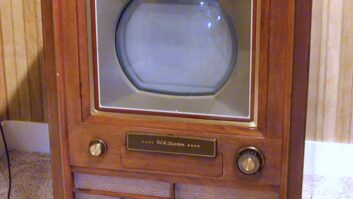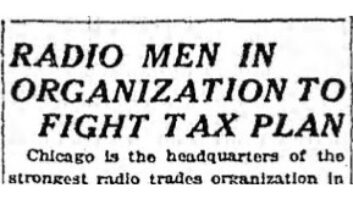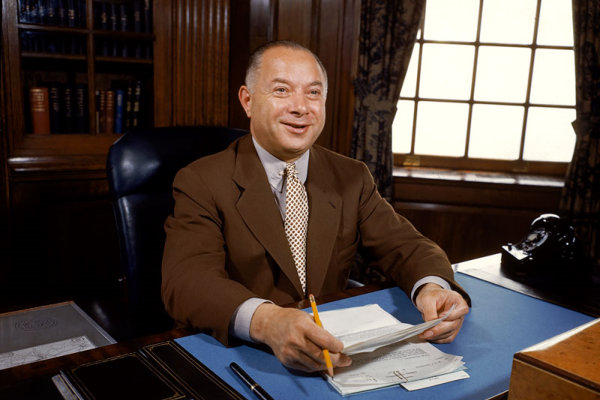
Editor’s Note: This year marks the 100th anniversary of the founding of the CTA (Consumer Technology Association), which started out as the RMA (Radio Manufacturers Association). This is the second in a series of essays exploring and celebrating CTA’s and our industry’s first century of invention, innovation, and entrepreneurship, assembled from varying technology historical research and writings I have done over the course of 20-plus years, including from an annually updated industry history for CTA’s now-defunct Digital America, 20-plus years of CTA Hall of Fame inductee biographies, and numerous tech history articles for a variety of publications over the years. Read Part 1: Founding here.
Imagine a single company that combined Samsung, Comcast, Universal Music Group (UMG), Cisco, and Lockheed Martin, and you’ll get an idea of the size, power, and breadth of RCA during its heyday from the early 1920s into the early 1980s. Now imagine this massive company ruled by one person. To paraphrase John Kennedy describing Thomas Jefferson, the greatest assembly of technology leaders occurred when David Sarnoff dined alone.
During the bulk of the 20th century, RCA was the world’s leading maker and seller of radios, record players, and TVs, was one of the if not the world’s biggest record label, ran not one but two of the major national radio networks (NBC Red and NBC Blue, which would become ABC) and then one of the big three TV networks, ran one of the Big Five Hollywood movie studios (RKO), led the U.S. communications technology effort during World War II, and became a leading satellite supplier during the Space Race in the 1960s.
And Sarnoff was the imperious lord of RCA and, in many ways, the consumer electronics industry – and not always benignly – in ways that more familiar subsequent tech tycoons such as Akio Morita, Steve Jobs, Elon Musk, or Mark Zuckerberg could never achieve. While Sarnoff was unquestionably a visionary, a bold leader, and a canny businessman, he, like many corporate executives, also could be a narcissistic self-promoter, ruthless, and unscrupulous.
Sarnoff
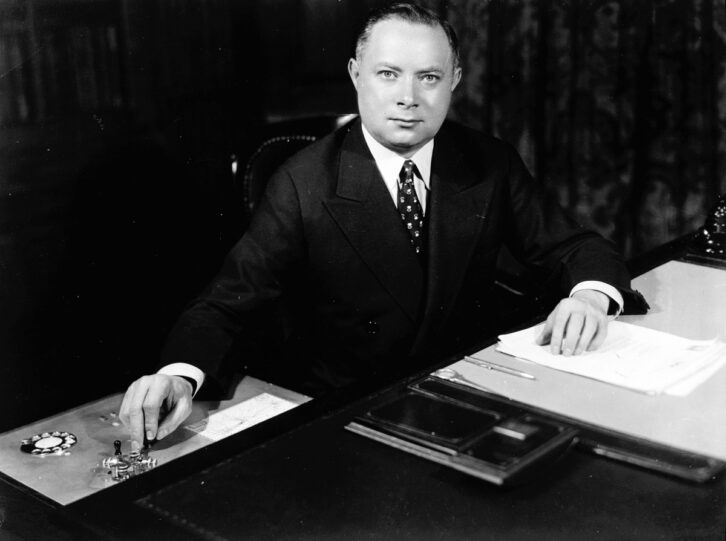
Sarnoff was born into abject poverty on February 27, 1891, in what was then Russia but now Belarus. He and his family moved to the Lower East Side of Manhattan when he was 9, and, like many immigrants, started almost immediately to fight his way out of the Jewish ghetto and to success. Within a few years, he scored a messenger job at Marconi Wireless Telegraph Company, with Marconi becoming a personal hero. Not content with his menial jobs, Sarnoff taught himself telegraphy, absorbed technical journals, and followed engineers into and around their workshops. At 17, Sarnoff was promoted to assistant operator. Throughout his life, he actively promoted the fiction that he had been the first wireless telegraph operator to receive messages from the doomed Titanic on April 14-15, 1912.
In the fall of 1915, before anyone had even thought of transmitting sound through air as a business – or even the word “broadcasting” – Sarnoff wrote a memo to his Marconi bosses: “I have in mind a plan of development which would make radio a ‘household utility’ in the same sense as the piano or phonograph. The idea is to bring music into the house by wireless…” His bosses, running what was then a purely wireless telegraph message company, filed the memo and forgot about it, but Sarnoff never lost faith in his vision.
When American Marconi was absorbed into the newly established Radio Corporation of America (RCA) in October 1919, Sarnoff was named general manager of the new entity. He correctly gauged the public’s interest in the July 1921 heavyweight championship fight between Jack Dempsey and George Carpentier. Broadcast live by RCA, the event drew thousands of listeners. Sales of radios soared.
Sarnoff later used alliances with GE and Westinghouse to create NBC, the first national radio network, filled with the first real programming supported by advertisers. In the 1940s, RCA’s record label, RCA Victor, released the first recordings on 33 1/3 vinyl discs, invented the 45 RPM “single,” and released the first records in stereo. Sarnoff also set in motion the race to develop videotape recording in the early 1950s.
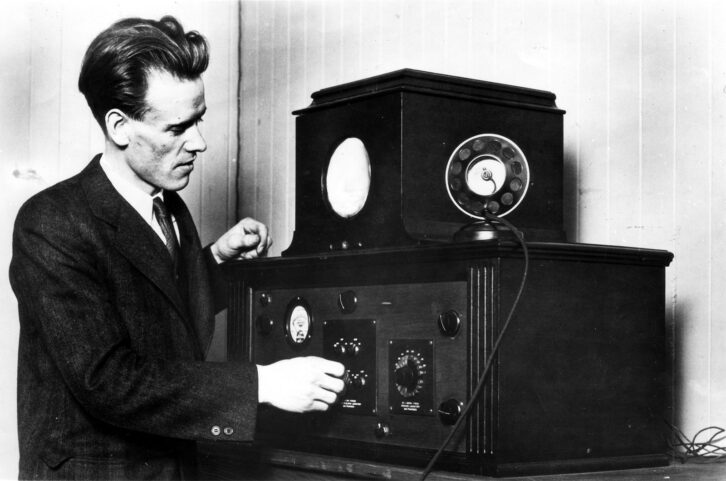
No one in our industry’s history combined the will, power, ego, and ambition Sarnoff wielded to transform his technology dreams into reality, regardless of what, how, or who stood in his way to achieve his goals. For instance, to establish RCA as TV’s inventor and primary manufacturer and himself as the father of television, Sarnoff used all the muscle at his disposal to deny Philo T. Farnsworth, the acknowledged inventor of electronic television, his patent rights and share of TV’s hardware profits. Sarnoff’s battles with Farnsworth have been the subject of numerous books and, in 2007, an Aaron Sorkin-penned Broadway play, “The Farnsworth Invention.” A broken and alcoholic Farnsworth died in March 1971, nine months before Sarnoff.
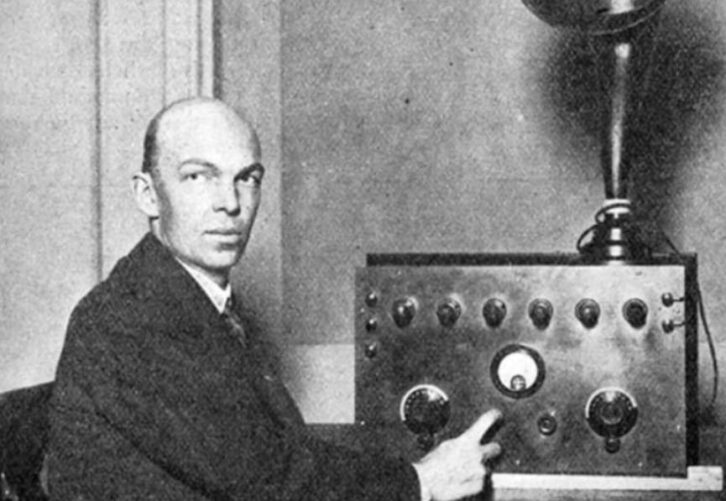
Fearing cannibalization of his AM radio empire, Sarnoff continually blocked and litigated against the establishment of FM radio by its inventor, radio pioneer, and supposed friend and RCA employee Edwin Howard Armstrong. This lopsided legal battle, similar to the battle waged by Sarnoff against Farnsworth, directly or indirectly led to Armstrong’s suicide in 1954 and forced Sarnoff to assert to the press that “I did not kill Armstrong.” (Here are links to Part 1 and Part 2 of a fascinating review of Sarnoff’s and Armstrong’s entwined relationship.)
When the FCC approved the non-backward compatible CBS color TV standard, Sarnoff rightly worked diligently, if not always scrupulously, to overturn the decision and get the more universally compatible RCA standard affirmed instead.
For his service as part of the communications effort for the June 1944 D-Day operations, General Dwight Eisenhower bestowed Sarnoff the rank of brigadier general. For the rest of his life, Sarnoff reveled in being referred to as “the general” or “General Sarnoff.” A virulent anti-communist, however, Sarnoff also was a supporter of Senator Joseph McCarthy and allowed blacklisting at RCA.
Economic Hard Times, Radio, and RMA Matures
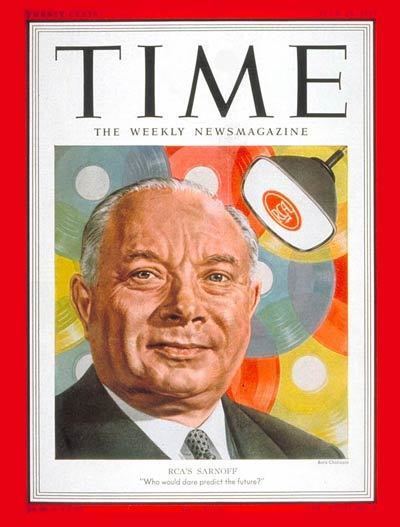
More impactful to the industry than Sarnoff or any technological breakthroughs in the 1930s, however, was the Great Depression.
The Depression prompted multiple RMA organizational changes. In 1932, RMA consolidated its Chicago and New York operations and established new Association headquarters in Washington, D.C. The following year, RMA ended its radio fair sponsorship due mostly to the shrinking number of exhibitors who could afford to display. RMA also was forced to avoid numerous attempts at being absorbed by the larger National Electronics Electrical Manufacturers Association (NEMA).
While the Depression depressed business, radio transformed from a consumer luxury into a necessity. By 1940, 82% of American households contained at least one radio, and around 25% of cars included one. With a new medium came new innovative content. Rather than just playing records and reading from newspapers, radio delivered a plethora of live entertainment and sports, as well as new forms of drama, comedy, game shows, and soap operas, culminating in Orson Welles’ panic-inducing “War of the Worlds” broadcast on Halloween night 1938. Burgeoning national networks such as NBC, CBS, and Mutual created their own news collecting and reporting operations, and his “fireside chats” enabled President Franklin Roosevelt to push his New Deal economic agenda and calm a nervous nation.
Not surprisingly, the growth of radio set sales led businesses to use the new medium to promote their products and services. In 1927, advertisers spent $4.8 million ($86 million in 2024) on radio; by 1940, ad expenditures had ballooned to $215.6 million ($4.8 billion in 2024).
TV Development
While radio and phonographs were the dominant – heck, only – consumer electronics products prior to World War 2, the next major high-tech product, television, had been in development almost before radio.
In early 1884, 24-year-old German engineer Paul Nipkow started playing with a spinning wheel with perforated holes that a thin beam of light passed through to scan an image that could be transmitted. Television, however, required not only transmission but a display screen. In 1897, German physicist Karl Ferdinand Braun invented the cathode ray tube (CRT).
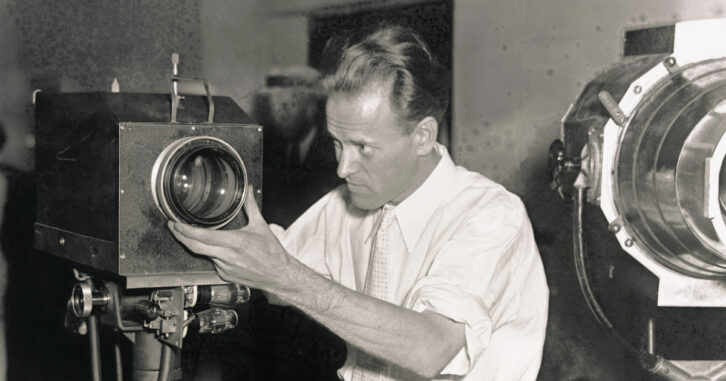
But it was a 14-year-old Idaho farm boy named Philo T. Farnsworth who made the first broad leap into all-electronic television. Farnsworth sketched out an all-electronic television system he showed to his chemistry teacher in late February 1922. This sketch, illustrating a “gun” that shot rows of electrons onto the inside of Braun’s cathode ray tube, would later prove the precedent for Farnsworth’s later television patent claims against Sarnoff and RCA.
Farnsworth was not alone in devising a television scheme. In October 1925, John Logie Baird, a Scottish engineer, produced the image of a recognizable human face and got his Nipkow Wheel-based system temporarily accepted by the British Broadcasting Corp. (BBC). Russian émigré and Westinghouse engineer Dr. Vladimir Zworykin filed for a patent on an electronic color TV system. By 1928, several companies, including NBC and the BBC, started limited television broadcasting.
Farnsworth’s and Zworykin’s almost identical all-electronic systems held the most promise, however. A long legal and business battle followed to determine who owned the patents and who actually invented television – a battle Farnsworth ultimately won, thanks to his early sketches, but much too late to yield practical or financial benefits to him.
As a result, Sarnoff and RCA are generally credited with initiating the age of television, despite Farnsworth being recognized as the technology’s inventor. In April 1939, NBC, owned by RCA, began the first regular broadcasts in the United States, including an address by President Roosevelt to officially open the New York World’s Fair.
It took two years, however, for a single TV broadcast standard to be adopted by the Federal Communications Commission (FCC). The National Television Standards Committee (NTSC), formed in 1940 by the FCC, came up with a single set of TV standards, and the first NTSC standard television pictures were broadcast on July 1, 1941.
America’s entry into World War II five months later interrupted further commercialization of broadcasting of any kind, as all civilian production of television and radio sets, along with all other consumer devices, was suspended. It would be postwar prosperity and major technical breakthroughs in the decade-plus postwar period that enabled the explosion of the consumer electronics industry over the subsequent half-century.
Significant Dates:
1930
- I.G. Farben AG develops magnetic plastic audio recording tape in Germany.
- Galvin Manufacturing unveils “Motorola,” a combination of “motor vehicle” and “victrola,” the first car radio, at the annual RMA convention in Atlantic City, NJ. (June 2)
- TV is demonstrated for the first time at the annual RMA convention in Atlantic City. (June 2)
1931
- Radio U.S. household penetration surpasses home telephone penetration.
- “Binaural,” better known as stereo recording, is invented separately by Alan Blumlein in England and A.C. Keller of Bell Labs.
- DuMont Laboratories is founded by Allen B. DuMont in Upper Montclair, NJ.
- Thomas Edison dies; lights dimmed around the world in tribute. (October 18)
1932
- The Emerson Model 25, the first “compact” table radio, goes on sale.
1933
- Edwin Howard Armstrong files patent for FM radio. (January 24)
- Guglielmo Marconi opens first microwave radio link, connecting the Vatican and the Pope’s summer residence. (February 11)
1934
- The International Electrotechnical Commission establishes technical committee TC 23 in the first attempt to standardize global AC electrical outlet and jack standards.
- The Federal Communications Commission (FCC) is established. (June 19)
1936
- The Berlin Olympics are televised, viewed by an audience of 150,000 over two weeks in “television rooms” across Berlin and in the Olympic Village. (August 1)
1937
- John Atanasoff begins work on the first electronic computer, completed in 1939.
- Chester Carlson files preliminary patent for “electrophotography” aka xerography, but it will be 22 years before the first commercial Xerox photocopy machine is introduced. (October 18)
- FCC allocates 18 channels for TV operation. (October 18)
1938
- Konrad Zuse invents and builds the first binary computer.
- Pioneer Electronics founded in Tokyo.
- Samsung founded by Lee Byung-chul in Daegu, Korea. (March 1)
- Herman Anthony of Rayovac files patent for first leakproof consumer battery. (May 31)
1939
- The first experimental FM stations go on air.
- David Hewlett and William Packard establish their company in a Palo Alto garage, founding Silicon Valley. (January 1)
- Television is introduced at the New York World’s Fair with speech by David Sarnoff. (April 20)
- RCA broadcasts President Franklin D. Roosevelt’s opening speech from the World’s Fair. (April 30)
- RCA, GE, DuMont, Philco, and two other companies sell the first television sets in several New York City stores for between $199.50 to $1,000; RCA begins first regularly scheduled TV programming. (May 1)
1940
- Radio sets reach an 80.3% household penetration rate in the U.S.
- CBS conducts first demonstrations of all-electronic color television. (August 28, September 4)
1941
- Commercial FM operation begins. (January 1)
- On radio “Moving Day,” following the adoption of the North American Radio Broadcasting Agreement, 80 percent of North America’s AM frequencies are reassigned to new channels. (March 29)
- Galvin Manufacturing/Motorola begins mass production of the “Handie-Talkie” SCR-536, the first mass-produced walkie-talkie. (July)
- The FCC adopts the NTSC standard and monochrome TV broadcasts begin. (July1)
1942
- The first all-electronic digital computer, Atanasoff-Berry Computer (ABC), is completed.
- The first stereo tape recordings are made by Helmut Kruger at German Radio in Berlin.
- All radio and television equipment production banned during World War II. (April 1)
- Hedy Lamarr and George Antheil granted frequency hopping patent. (August 11)
1943
- Nikola Tesla dies penniless in the New Yorker Hotel in New York City. (January 7)
1944
- Ampex founded by Alexander Poniatoff.
1945
- The FCC allocates Citizens Band radio frequencies.
- Arthur C. Clarke proposes a geosynchronous orbit communications satellite system. Twenty years later, this GEO is dubbed the “Clarke Belt” in his honor. (May 25)
- U.S. War Production Board ends wartime ban ona the manufacture of consumer radio and television equipment. (October 1)
About the Author
Stewart Wolpin has been covering the consumer technology industry for more than four decades, including for TWICE since its founding. He’s authored a slew of technology history articles and has written the bulk of the biographies of the Consumer Technology Association Hall of Fame inductees. He’s also written “Bums No More: The Championship Season of the 1955 Brooklyn Dodgers,” and “The Rules of Neighborhood Poker According to Hoyle.” You can see his technology reportage, historical and current, at stewartwolpin.com.
See also: CTA Centennial Part 1: Founding





